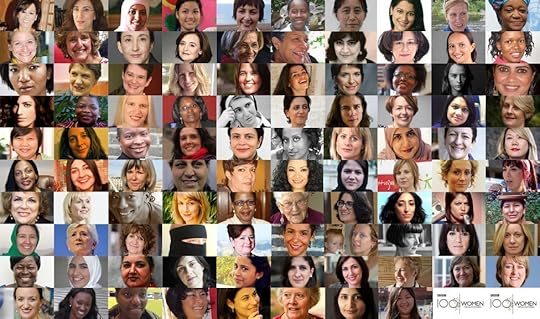Shelina Zahra Janmohamed's Blog, page 5
October 27, 2013
Breaking news: Muslim women like sex too. Who’d have thought it?!
My thought piece published yesterday on The Telegraph’s Wonder Women site.
After the launch of a Halal sex shop, one which is proving popular with women, Shelina Janmohamed implores society to stop just seeing female Muslims through the prism of a veil.
An online Halal sex shop has just opened its digital doors out of Turkey. Over its first weekend it received more than 30,000 visitors.
Wait, what? A sex shop for Muslims? And one that is popular with Muslim women?
As a society, our discussions about Muslim women only go as far as whether they should wear hijabs, niqabs and burqas. Sometimes we think veiling is oppressive. Bizarrely, sometimes it’s seen as a bit saucy. But mostly we are just not sure if Muslim women should be allowed to decide for themselves.
And then along comes a story of aphrodisiacs, orgasm creams and Halal lubes that Muslim women (perhaps literally) are sucking up. Whilst this is exciting news for Turkey (will there be a baby boom in July 2014?), it’s not a world first. We’ve already seen plenty of coverage in the Netherlands, Bahrain and even Atlanta, USA. So why is a Muslim sex shop that women love, such big news?
Let’s pan out, and take a look at the landscape of ideas and news coverage when it comes to Muslim women. This week alone, Channel 4 news is running a series on “Britain’s niqab”. Barely weeks ago, Britain had its burqas in a twist at the thought of meeting a doctor who covers her face. (helpful tip: there aren’t any in the UK.) And it’s not just the UK that’s in a tizzy. Belgium passed a law banning the face veil, despite there being only thirty women who the country who wear it. Couldn’t the PM just call them round for a cup of tea and a chat instead to discuss their niqabs?
It’s a bit, erm, kinky, that what captures our imagination about Muslim women is either veiling or sex. Are Muslim women exotic and oriental, an ongoing titillation and sexual fetish for our consumption?
I think the answer is much simpler: Muslim women are depicted simply as bodies, covered or uncovered. Any deviation from this script is heavily policed. Ask Google images about Muslim women and you’ll get pages of black cloaks, with the odd nude women wearing nothing but a face veil. You’ll also find Lady Gaga in a gauzy neon pink burqa, Madonna with a bizarre niqab made of chain mail, and a Diesel Ad of a naked tattooed woman and denim burqa. No, I’m not making this up.
Women as a general rule face the challenge of being seen as nothing but bodies, but the problem is heightened for Muslim women where the entire debate focuses on what we do or don’t wear and whether we are brainwashed into our choices. Surprisingly even self-identified feminists will reduce Muslim women to what they wear, rather than hearing what Muslim women have to say.
Yet the female Muslim experience – including in Halal sex shops – has something experimental to offer women in general. There are women-only spaces created by Muslim women where a celebration of womanhood takes place outside the male gaze.
When so much of the feminist debate is dedicated to understanding what beauty, body and femininity mean when freed from the male gaze, these spaces already exist. These are finally places where ubiquitous sexualisation of the female form is banished. Weddings and parties are the most popular where Muslim women can explore what it means to be beautiful and sexy for themselves, and even do so across generations, without worrying about men.
Online Halal sex shops like this latest one in Turkey extend that courtesy to their customers, taking away the almost pornographic images. The owner of El Asira in the Netherlands, says that many of his customers are women who are not Muslim, because they find the imagery and tone less off-putting than traditional blue imagery. Halal sex shops give the chance to women to explore their sexuality without imposing pornographic norms.
Talking openly about sex and pleasure has only recently lost its taboo status in the West. It’s true that its public discussion in Muslim cultures is still difficult. However, in private among Muslim women, it’s as of much interest as anywhere in the world.
Muslims have form on the subject too, with love, sex and erotic manuals dating as far back to the eighth and ninth century Abbasid Muslim period. Rumi is perhaps the most famous of Muslim poets globally, he wasn’t shy about sexual references. And even the Prophet Muhammad pronounced that to deny women foreplay was a form of oppression.
A popular American Muslim scholar even has this to say: “There is certainly a case for producing an advanced manual in English drawing on Islam’s rich legacy in this field.”
So a sex shop that appeals to Muslim women is fun, important, and just as natural as everyone else’s lust. Stop the presses! Muslim women like sex too. Who’d have thought it?
October 21, 2013
I’m part of the 100 Women project by the BBC
Exciting news! The BBC is running a project called “100 women” which they’ve announced today. It’s part of their season focusing on women. I’ve been selected as one of the 100 women from around the world.
Here’s what they say about the project:
“They hail from all over the world, and from walks of life. They do all kinds of things: they make music, save lives, raise children, run businesses, write, preach, act and tell jokes. They campaign for their causes and strive for a better world for themselves and their families. On Friday 25 October they are coming together at the BBC’s London headquarters, Broadcasting House, for a unique day of debate and discussion. We’ll ask them to tell us where they think the world’s women are today, and to set out their goals for the future. You’ll be able to follow every development on BBC TV, radio and online.”
So watch out for more details over the coming few days, and make sure you’re tuned in over the course of Friday for the wide range of broadcasts.
Here’s the link to the 100 Women.
And a snapshot of the 100 women who make up the project. It’s an interesting attempt to look at the diversity of women today, and what it means to be a woman.
October 19, 2013
Calling all feminists: Get over the veil debate, focus on real problems
(Posting belatedly, my op-ed for Al Jazeera, in the midst of the debate about forcing doctors who wear the niqab to remove it).
For western feminists, the debate about the niqab that has been running in the UK is around choice. Have Muslim women who say they have chosen to wear a niqab really exercising free choice? And even if this choice is free – ‘free’ in the broadest sense of the term, say western feminists’ – is it very feminist? I believe this argument is short-sighted and misses the bigger picture that women’s rights movements need to work together. Women around the world need to get over the obsession with the veil and work with Muslim women, and here’s why: we are all on the same side, and we need to lay some ground rules that will help us work together to eradicate the problems women face around the world.
 The arguments being aired around choice apply to hijab as well as niqab, as well as the broader right to be respected for being a Muslim woman. That’s one of the reasons why the recent debates and news coverage have featured so many Muslim women who don’t wear a niqab or any headcovering at all. To the Muslim women you’ve seen and heard in the news, this feels like an attack on our status as women who want to be Muslim, veil wearers or not. For many decades women who follow a religion were excluded as unable to be part of the feminist movement. Muslim women reject that. We believe that the movement towards more gender just societies must absolutely include women of religion if we are to achieve global and lasting change.
The arguments being aired around choice apply to hijab as well as niqab, as well as the broader right to be respected for being a Muslim woman. That’s one of the reasons why the recent debates and news coverage have featured so many Muslim women who don’t wear a niqab or any headcovering at all. To the Muslim women you’ve seen and heard in the news, this feels like an attack on our status as women who want to be Muslim, veil wearers or not. For many decades women who follow a religion were excluded as unable to be part of the feminist movement. Muslim women reject that. We believe that the movement towards more gender just societies must absolutely include women of religion if we are to achieve global and lasting change.
The manufactured veil controversy
Let’s tackle some basics in the niqab debate.
First, security. Contrary to high-pitched opposition in the media discourse, women who cover their face are happy to lift their veils for identification such as in airports to ensure security.
Hygiene is another red herring for banning niqab. When the UK introduced legislation that health professionals could not wear sleeves beyond the elbow, Muslims have complied. There’s no reason to suggest any hygiene related guidelines on the veil would not be adhered to with similar pragmatism. Besides, even the UK’s Secretary of Health admitted that he didn’t know of any niqab-wearing doctors. And don’t surgeons cover their faces anyway? In parts of Asia, covering your face with a mask is a form of consideration to those you are engaging with to avoid sharing your germs.
When these non-excuses are dealt with, we start to get to the crux of the matter: Muslims are not ‘like us’, and they wear veils to keep themselves separate. If the position you start from is that Muslims are ‘other’, then no wonder interaction is difficult. If anything, it is precisely because these women have entered into the public space in order to engage and integrate that we are having this debate. If they stayed at home, we’d have nothing to talk about.
Feminists beware
Feminists must be cautious of when their sentiments and actions are swept up to bolster the rising tide of anti-Muslim hatred. The Sun newspaper demanded on its front page that Muslim women be unveiled. Muslim women have had their veils forcibly ripped off. A pregnant Muslim woman was kicked in the stomach.A woman in Germany who wore a headscarf was stabbed eighteen times in open court. It is Islam that is the problem, not Muslim women, Muslim women are told. That’s cold comfort to a Muslim woman being physically attacked.
The Ukrainian ‘feminist’ group Femen told us that we were slaves and they would free us. Their topless jihad was the route to liberation. (We’ve found out subsequently that they were being managed by a man who only picked the most attractive of women.) Whilst Femen may be more extreme than most, their idea that western feminists will free Muslim women is a sentiment widely shared. It infantilises Muslim women. How can we engage if you treat us as lesser beings? Respect must be the crucial foundation. This is also lacking in some extreme Muslim discourse that refers disgustingly to non-veiled women as raw meat, and fair game. Mutual respect is a sentiment which will foster better outcomes for all.
‘Whataboutery’ and the road to nowhere
My favourite anti-veil opposition – and the argument that feminists fall back on – is the argument of‘whataboutery’. What about women who are forced to wear a veil?” They cry! “What about Afghanistan, we fought a war there to free women!” “What about the women who died to give up the veil?!” I’m not convinced yet that the imperialist enterprise in Afghanistan has improved women’s situation greatly, and I’m equally unconvinced that denying women’s rights to choose how they dress in one country improves life for those who are forced to veil. Our standard for women’s rights should not be on a par with those who force women to wear a veil. We must lead the way, not pander to the oppressive common denominator.
The challenge for feminists of all stripes in this debate is that all the arguments have pitfalls. If you ban it to ’save’ the women who are forced, then what of the free will of those who have chosen to wear it, but are now prevented from doing so? And this is even before we even know how many women are actually forced to wear it.
If the feminist argument is that Muslim women who autonomously choose to veil only think they are doing so out of free will, and are in fact being brainwashed to do so, then the core principle of feminism to elevate women’s control of their own destiny is immediately violated. And worse, it underscores the argument that feminism is a western imperialist project: that only western culture can supposedly liberate women, and that all other ideas are brainwashing. Perhaps the most insulting subtext of all is that Muslim women are infants, to be patronised into the ‘right’ choices.
If Muslim women are brainwashed into veiling, then is the mini-skirt generation equally brainwashed into believing that showing skin is liberation?
Veil tourism
This idea underpins a current flurry of veil tourism. This is when a well-meaning journalist ‘gets behind a niqab’ for a day (or more) and then keeps a diary of her experiences, inevitably concluding that it was hot and she felt repressed.
Wearing a veil for a day can give you a taste of the physical aspects. Most veil tourists talk about the heat and the restriction. They can also offer a taster of the social interactions that women who wear a niqab experience: the negativity, the hostility and even the public humiliation. Wearing a niqab for a day sounds like a good idea, and I applaud the notion of walking in another woman’s shoes. But almost every journalistic piece enters the project with scepticism and looks for reinforcement of their arguments. It is seen as an item of clothing, rather than, as many Muslim perceive it, an expression of something deeper.
I could write a piece about wearing very high heels. It would read much the same: they constrict my walking, they make my ankles hurt. Men in the street feel legitimate in yelling things at me. It doesn’t help deepen the debate or go beyond it.
Veil tourists I believe are genuine, but fail to grasp that the veil means something more to the women who wear it, and for whom, therefore, any hardships are either accepted as the price for a bigger cause, or for whom the difficulties are simply not difficulties.
Calling all feminists
The debate around veiling will run and run. It stokes provocative debates – and rightly so – about the nature of choice, women’s place in the public and private spheres, and the relationship between women, religion and patriarchy. To have these debates between women from vastly different backgrounds, religions and perspectives makes the debates richer and more complicated. It is in the true tradition of feminism to hold our beliefs up for examination and this must be done honestly by all feminists, those women who veil and those who don’t.
Whilst it is important to the future of feminism to have these ideological debates, what is more important is to avoid getting distracted by little pieces of cloth. If Muslim women say it’s a choice to wear it, let’s respect them. Let’s put an end to the headline: “Woman wears piece of cloth.” Let’s move on.
What is more important is to realise we share more in common in terms of the problems we must tackle together as women. These range from topics as wide and fundamental as poverty, education and legal rights, to access to healthcare, domestic violence, public engagement and political influence and everything in between. These are the same challenges for women around the world but under different labels and manifestations. Let’s address them together.
Feminists: stop fighting over what I wear, and start addressing who I am. I am neither burqa nor bikini. I am woman.
The struggle to find the line between my public persona as a woman, and the privacy of my child (or how every aspect of motherhood is a challenge)
My weekly newspaper column for The National.
I remember when the first labour pains started. I had just finished writing my column for The National, attached it to an email to my editor and pressed “Send”. It was after midnight and I was perched in bed. I clicked my laptop shut, sighed with relief and snuggled up. An hour later I felt contractions.
 That clicking sound remains loud in my mind, the sound of the door closing on me as an individual, a single public entity. Seventy-two painful hours later, I gazed into the jewel-like eyes of my baby daughter as my husband, smiling, gave her to me to hold. I had a mini-me.
That clicking sound remains loud in my mind, the sound of the door closing on me as an individual, a single public entity. Seventy-two painful hours later, I gazed into the jewel-like eyes of my baby daughter as my husband, smiling, gave her to me to hold. I had a mini-me.
Except as the days passed, and the fog of new motherhood lifted, I felt strongly that she wasn’t me. She was a creature of her own. It was her right not to be part of my public life. I confronted the fact that she had her own new existence, like a small green shoot. Bright lights would burn her. She had a right to privacy and my duty was to shelter her from that glare.
It’s hard to keep the most intimate and beloved person in my life private. She’s adorable, smart, funny and beautiful. Her existence shaped every breath of mine from that moment. Her very being, her smile, her complaints, each action and expression intimately informs who I am.
The paradox is that I am still the same independent woman, individualistic even, who clicked shut that laptop that night, but you cannot understand me, I cannot understand myself, without knowing her.
The paradox is that while I continue to fiercely desire to engage publicly with my ideas and activities, I feel more fiercer still that my child, one of the great influences on me, should be part of my private life only. The paradox of the fierceness with which I guard her privacy could be a hyper-assertion of my motherhood, emphasis through absence.
There are no public photos of her. It was only after long and anxious reflection that I offered her name up to the public. This is unusual in our world of Facebook photos and Twitter selfies. Many parents I know on social media use images of their children as their profile pictures. For them, their children are the full embodiment of their public persona. My profile has a noticeable absence of family photos.
The increasing numbers of women in the public eye combined with our ever more powerful social media will mean that how to balance our public and private lives will become a bigger decision for more and more parents, but especially for mothers in the public eye. Social expectations on women usually demand we marry and have children, and that our status on both issues be a matter of public knowledge. But I don’t think children should be collateral damage from the pressures on women.
I’m flouting the laws of modern motherhood that require public evidence of being a mum. Also, my assertion of myself as my own woman, with my own ideas and my own journey to conduct in the public space is quietly and positively subversive, stating that I exist independent of my persona as a mother. It’s a difficult decision, because it doesn’t mean I don’t feel sad not to share my beloved with the world. Privately, my feelings and photos are shared boundlessly.
I am both individual and mother. For me, I want you take me on my merits; for her, I want to protect her. Publicly I’m proud to assert that being a mother has made me the woman I am today.
Can men ever learn to love chick flicks? Not until empathising with women is a natural part of society’s status quo
My weekly newspaper column for The National.
It’s a luxury to have an evening to spend simply watching a film from the sanctuary of the sofa. I ask my husband if we can watch a romantic comedy, and he concedes out of affection. Plus he knows the important statistic: romcoms result in a higher ratio of per-minute cuddling than any other movie genre.
 When it comes to films, chick flicks are supposed to be only for women, and no self-respecting man would think to declare that what he really wants to watch is a romcom. It’s usually under duress from his female partner that he’s forced to sit through a formulaic plotline of will-they-won’t-they-yes-they-will.
When it comes to films, chick flicks are supposed to be only for women, and no self-respecting man would think to declare that what he really wants to watch is a romcom. It’s usually under duress from his female partner that he’s forced to sit through a formulaic plotline of will-they-won’t-they-yes-they-will.
The most obvious reason seems to be that they are too emotional for men, who aren’t allowed to admit a hankering for romance. Romance is that girlie, soppy stuff that will result in mocking for any male exponent.
The male lead is the standard for films, as well as books, the norm that both men and women are expected to connect with and relate to. But as soon as a female character is the lead, it’s a story for women only. So no wonder that chick flicks are belittled as being for women only: the female is the lead and the men play the same character in every film; their role to be interchangeable and act as screen sweets. The latter is, of course, exactly how women feel about themselves portrayed in films generally. I’d like both to be more rounded, not just one-dimensional and pretty.
There are chick flicks that appeal to men. There’s Something about Mary was a global hit. So was Notting Hill. Broad appeal films like these don’t expect male viewers to have to empathise with the heroine. The cynic in me says that these films let men off the hook from finding it totally natural to relate to a female character. It would be nice if they did. Instead, which is just as important, they have strong male characters which allow men to invest in the film. If only moviemakers would apply the same strong characterisation to female characters in films with a male lead.
Of course, even I will admit that many chick flicks are just simply rubbish. Weak characters and unbelievable plot lines can render them into dire productions. And I’ve been at the front of the queue to criticise them for creating the archetypal passive princess waiting to be rescued by Prince Charming, at which point life will be perfect.
I’d have no hesitation in condemning chick flicks, except for the fact that the terms “chick flick” and “chick lit” refer not just to romantic comedies. Sometimes they refer to anything about women or featuring female characters. The tone of the terms is to disparage the art as subgenre, deviating from the male norm or just a bit girlie and weak.
I’ve been trying to figure out what the opposite to a chick flick would be. Some of the suggestions are rude, so I can’t write them here. (Google is your friend if you want to know.) But I have the sense that the opposite of a chick flick would be awesome, energetic, realistic and, most importantly, it would appeal to everyone, not just women.
Movie-makers and publishers need to change the characterisation of the male and female leads, but we also need a change in society. Both men and women have a need to see the subjects of emotions and love, as well as female leaders, role models and protagonists as totally normal on and off-screen. Love and feisty chicks, they are for everyone.
Life epiphanies, the hajj, politicians and how to make a change
This is my weekly newspaper column published in The National today.
As this year’s Haj pilgrims make their way back home, they will be travelling with mounting expectations of major life changes.
 Tradition gives them a new honorific, haji or haja, and with this comes an elevated status, one that each pilgrim must live up to with new-found piety.
Tradition gives them a new honorific, haji or haja, and with this comes an elevated status, one that each pilgrim must live up to with new-found piety.
More important than what others expect is what the pilgrims themselves anticipate – a real change in their own actions and lives after their pilgrimage.
Completing the Haj is seen as a moment of epiphany. The old hedonistic life must be abandoned, as the body and soul experience a transformation that leads – or is supposed to lead – to a life of goodness and devotion.
For many pilgrims, this is just what happens. The extraordinary nature of the Haj creates the right conditions for them to step out of the smallness of daily life.
The new environments, experiences, people and challenges of the Haj, coupled with the religious experience after lifelong anticipation, can bring about a true new beginning.
Even ordinary travel can create some of the conditions for epiphany. Many people craft voyages expressly to create the conditions for a life change that they have no other way to trigger.
My own experience of motherhood had a similar effect, throwing me into a novel and unexpected struggle, and giving me a whole new perspective on life.
Events like these force us outside of our routines, and thrust us into challenges so radical and transformative that we are almost guaranteed to rethink how we live and what we want from life.
If you’re seeking an epiphany, take note that these big life events are most transformative because they are public, meaning those around us have also bought into the upcoming change. This helps us maintain our own inner momentum.
For the returning hajis, if their quest was intended to trigger a life change, they may find that their friends and family will be even more zealous than they are in policing the move to piety. With motherhood, too, your social circle accommodates and supports your change.
In other cases, there is no public marker for major personal change – this is where sustaining a life reform becomes challenging. There is nothing external to send people a signal that you intend to be different now, so those around you may not understand, support or accept it.
In some cases, too, changing your mind about major matters can be seen by others, especially those outside your immediate circle, as evidence of weak-mindedness. This is particularly a challenge for social and political leaders. We leave them almost no room for epiphanies and improvements in their way of living and working.
For leaders, sometimes the only change permitted is one that comes through social and political pressure. In this case other people, with their challenging, unapologetically in-your-face views, are the agent of transformation. Their opinions create the conditions required to trigger an epiphany in the leader, but also the broader social conditions that allow prominent people the space to change.
The return home of the pilgrims is symbolic for all of us. The hajis have their epiphany to spur their change. For the rest of us, this can be a spur to create the right conditions in society so that those who wish to change their attitudes and lives have the chance to do so. We can do the same for our leaders. There’s a transformative thought.
October 10, 2013
What is it that we take from our fathers?
This was written last week in response to the UK event around the publication of Ed Miliband’s father’s story in the Daily Mail. This column was published in The National.
 Our future is tied to our history and the history of our fathers. We take their names, we adopt their habits, they positively and negatively influence our views. Rightly or wrongly, how others view us is influenced by who our fathers were.
Our future is tied to our history and the history of our fathers. We take their names, we adopt their habits, they positively and negatively influence our views. Rightly or wrongly, how others view us is influenced by who our fathers were.
Ed Miliband, the leader of the UK’s opposition Labour party has been the target of the leading right-wing tabloid newspaper The Daily Mail. The newspaper ran a feature on his father, Ralph Miliband, with the damning headline The man who hated Britain.
Instead of shrugging off the attack, Ed Miliband surprised the press and politicians and earned himself the admiration of the general public by standing up to the newspaper. There was clearly politics at play: to allow his loyalty to be questioned would be fatal coming up to the elections in 2015. But there has been a consensus that attacking a man’s father is one step too far, and that the younger Miliband has done what any of us would do: defend our father and uphold his memory in shaping who we become.
Ed Miliband’s response was crushing: “Fierce debate about politics does not justify character assassination of my father, questioning the patriotism of a man who risked his life for our country in the Second World War.” Ralph Miliband was a refugee who fled from Belgium to escape the Nazi occupation. He volunteered to join the Navy and fought on D-Day. He was also a left-wing Marxist intellectual who opposed Stalin. He was critical of how the few could pervert the machinery of state for their own purposes.
At the same time as Ralph Miliband was fleeing the Nazis, the Daily Mail was an ardent supporter of Hitler, praising him and profusely wishing British youth would take inspiration. Viscount Rothermere, infamously pictured shaking hands with Hitler, is the great-grandfather of the current owner of the Daily Mail. He and Hitler were exchanging friendly telegrams as late as 1940.
The younger Miliband is fearsome in personal defence of his father, but distinguishes his own politics. Today’s Viscount Rothermere squirms when reference is made to the support given to Hitler but has never apologised for the fascism and hatred promoted in his paper in the 1930s and 1940s.
As children, we are keen to assert our sense of self and independence. Finding a balance between declaring “I am my own person” while feeding the seemingly genetic compulsion to uphold our paternal legacy is a challenge we see among so many leaders. This is particularly true for those who hold power, and whose fathers were also political figures. For elected leaders following in the footsteps of their own elected fathers this is harder still as it’s hard to know if they are in power as proxies for their fathers, or for their own politics.
The three most famous women facing this challenge hail from the Subcontinent: Benazir Bhutto, Indira Gandhi and Sheikh Hasina. It’s undeniable that their paternity has played an overwhelming role in their rise to power. Cynics might argue that it’s the only reason they were elected.
Once in power their relationship with their paternal legacy has varied. Bhutto strove to complete the legacy of her father. More controversially Sheikh Hasina seems hellbent on settling scores for her father, perhaps wishing to avoid finding herself in his shoes.
To uphold the memory of fathers takes bravery. To ensure we learn from any mistakes and improve the trajectory they set us upon requires us to be braver still.
September 20, 2013
The UK and the niqab: We are more than what we wear. Deal with it.
This is my weekly newspaper column published today in The National
Hijabs, niqabs and burqas have dominated British news this week. Who knew that such tiny pieces of cloth could upset an entire nation? I calculate that the number of women in the UK who wear the niqab is at most .001 per cent. So why is Britain in such a state?
A college in Birmingham, the UK’s second city, instituted a ban on the niqab, citing the need to identify students on campus to keep the college safe. A huge counter protest led to a rapid reversal of the decision.
Also this week, a judge issued a ruling about whether a defendant who wears the niqab would be permitted to wear it in court. His detailed and reasoned judgment was that the defendant would have a screen protecting her from public view during the limited times she would be required to remove it during the trial proceedings. This was to allow the judge, jury and accused to observe her reactions to the trial in order that open justice – one of the principles of UK law – could be conducted. At all other times the defendant would be permitted to wear her niqab. It’s an excellent balance between the competing rights of the defendant to freedom of religion, and the rights of the other participants in the legal proceedings.
This week’s drama is about more than these two incidents. The pretext is the niqab, but it’s really an excuse to talk about Muslims as “backwards”, “oppressive” and “different to us”.
One key argument against the niqab is a supposed feminist line of “freeing” women from the “force” to wear it. We can see how crazy the feminist discussion is by pointing to that bastion of women’s rights and liberation, the Sun newspaper, notorious for its Page 3 girls. No surprise then that their front page this week demanded that Muslim women be “unveiled”. They just can’t bear that women should be covered.
There is much talk of a ban helping women who are “forced” to wear the niqab. Nobody knows how many women are forced, if any. It’s just an unchallenged trope that Muslim women must be forced. A ban would not help but rather fail any women who are forced by placing further restrictions on their engagement with society. But it would also infringe the rights of women who freely choose to wear the niqab.
Security is touted as another reason to ban the niqab. But in airports, women generally comply with procedures for identification, so this is a red herring. When banks face a slew of niqab-covered robbers, we can revisit the discussion.
The debate about the niqab is a smokescreen for a constantly recurring and frightening debate that’s really about whether the UK wants Muslims in society. The country is going through a long recession, and history – especially European history – is a powerful teacher that there is danger when minorities are targeted with constant hostility during times of economic uncertainty.
Politicians see easy votes in stirring populist fears, but the real victims are Muslim women who suffer the brutal physical consequences of attacks and intimidation. Feminists should realise that “saving” one group of women by oppressing another group is not a victory.
Liberal hearts may be in the right place by accepting differences in the way we live, but they uphold the misguided notion that Muslim women are all oppressed submissive slaves.
Mostly, it’s just tedious. There’s far more interesting and fundamental things to talk about when it comes to Muslim women than how we dress. We are more than what we wear. Deal with it.
September 17, 2013
Pageants don’t help women win rights
My newspaper column from The National
Beauty pageants continue unashamedly in the 21st century. This year Miss World, the first and oldest global beauty contest, is holding its pageant in Indonesia.
It’s instructive to note that Miss World began, in 1951, as a bikini contest, with commercial intent: to promote this new type of swimwear.
Indonesia has 242 million people, and 87 per cent of them are Muslim. It is one of the world’s fastest-growing economies, with an affluent middle class.
The contest has generated opposition from various groups there, including a small protest by about 200 hardliners. Their sentiment has been echoed by the more mainstream Indonesian Ulema Council, which told the government to abandon the competition as it violates Islamic teachings. A compromise, in which the swimwear competition would include sarongs, was rejected by the Council. The 2002 Miss World pageant, scheduled for Nigeria, was forced to relocate after similar but more heated controversy.
The search for Muslim beauty queens has been gathering pace. In 2010 Rima Fakih, of Lebanese origin, became the first Muslim Miss USA. Some hailed her win as a step towards redefining the white Caucasian beauty norms that dominate western media and advertising.
The Miss World contest – like the beauty market in general – has been trying to broaden its global appeal. There’s no doubt that commercial forces, similar to those that launched Miss World as a bikini promotion, now recognise the potential for profit if Muslim women begin to see themselves reflected in global beauty brands. As a case study, look how the beauty market exploded in India after Aishwarya Rai Bachchan became Miss World 1994, just as the Indian economy began its dramatic ascent.
Feminist opposition to beauty pageants is well documented: women are viewed as physical and sexual objects, their value is rated by looks, and the contests promote one homogenised standard of beauty.
So it is bizarre that in the context of the global, western-driven discussion about Muslim women’s rights, that Muslim women should be expected to strip down and compete to be “beauty queens” as a sign of liberation and progress.
A UK Muslim model criticised by other Muslims for entering the Miss Universe contest got huge media coverage when she said critics were “jealous” and “want to control women”.
Breaking free of male control is the same justification used by “nude bloggers” such as Amina Tyler of Tunisia, who published a bare-chested photo of herself in cooperation with the Ukrainian radical feminist group Femen, Aliaa Mahdy in Egypt and the Paris-based Iranian model and actress Golshifteh Farahani. Women may feel that there are only a few ways to reject male control over their rights, and I can understand why women choose stripping, or pageantry. But this approach, and applause for it, are misguided. Western feminism has undoubtedly brought many positive changes. However, in recent years we have seen clearly that “empowerment” through nudity can turn sour, reinforcing the control and exploitation of women as physical and sexual objects under the banner of “choice”. Instead of giving women freedom from being judged, it has reinforced their portrayal as beauties and bodies.
The crucial fight for women’s autonomy must continue, but we must learn the lessons of the feminist movement so far and avoid making certain mistakes again.
September 14, 2013
The advertising campaigns aiming to end domestic violence by subverting cultural icons
This is my weekly newspaper column for The National
In the fight against domestic violence, every victory is to be celebrated. Late last month, Saudi Arabia approved a law to make domestic abuse a criminal offence.
This is a leap forward in paving the way towards a clear public standpoint, that violence against women is not acceptable and there are no excuses for it.
Violence against women, particularly by family members and partners, is all too often tolerated, with the excuse that it’s a private matter.
 The legal change follows a summer advertising campaign that featured a woman in a black hijab and niqab, with a very visible black eye. The advert carries a clear caption: “Some things can’t be covered – fighting women’s abuse together.”
The legal change follows a summer advertising campaign that featured a woman in a black hijab and niqab, with a very visible black eye. The advert carries a clear caption: “Some things can’t be covered – fighting women’s abuse together.”
The image is at once familiar and disturbing. Its simplicity unapologetically highlights the issue. The campaign raises the subject of domestic violence in a society that doesn’t publicly acknowledge or challenge the problem. The blind eye to violence, the tacit acceptance of it, is a trap for abused women, for which everyone in society bears responsibility. So the advert tells each abused woman she is not alone, and that her suffering no longer needs to be hidden.
Over on the subcontinent, an Indian charity has been running a campaign about the prevalence of domestic violence. Those adverts feature goddesses revered in Hindu tradition, showing marks of violence on their faces and bodies. The caption reads: “Pray that we never see this day. Today more than 68 per cent of women in India are victims of domestic violence. Tomorrow, it seems as if no woman shall be spared, not even the ones we pray to.”
prevalence of domestic violence. Those adverts feature goddesses revered in Hindu tradition, showing marks of violence on their faces and bodies. The caption reads: “Pray that we never see this day. Today more than 68 per cent of women in India are victims of domestic violence. Tomorrow, it seems as if no woman shall be spared, not even the ones we pray to.”
Taking on the issue of domestic violence through a society’s own icons – the niqab in Saudi Arabia and goddesses in India –sends a powerful message. Both campaigns highlight the contradiction at the heart of these societies, by pointing out that the pedestals upon which women are supposedly placed do not really exist, in fact the opposite is true; women suffer oppression.
The hijab and niqab are explained as an honour for Muslim women, a protection and a symbol of their high status in Islam. Yet these adverts show how this modesty is twisted by the perpetrators of violence.
The Indian campaign highlights a similar contradiction – that the divine feminine is revered, and yet women themselves are beaten and abused.
There are criticisms of these adverts. The Indian campaign is obviously at risk of trapping women on their pedestal, by setting the goddess as the standard for women to live up to; they can then be berated for falling short of that unattainable standard.
 In the UK, a dramatic advert called The Cut showed Keira Knightley returning home from filming and being confronted by her boyfriend, who accuses her of having an affair. He attacks her and we see her being kicked repeatedly as she lies on the floor.
In the UK, a dramatic advert called The Cut showed Keira Knightley returning home from filming and being confronted by her boyfriend, who accuses her of having an affair. He attacks her and we see her being kicked repeatedly as she lies on the floor.
But then she yells “cut” to stop the filming – but the kicks continue. In this case, we see how women can be held to standards of beauty and celebrity, but behind closed doors can face violence. Ironically, that advert was condemned as too violent.
No campaign on such taboo subjects can be without controversy.
These adverts should make society open up about the double standards to which women are held. At the same time, the taboo about domestic violence must be broken permanently.
Shelina Zahra Janmohamed's Blog
- Shelina Zahra Janmohamed's profile
- 175 followers





